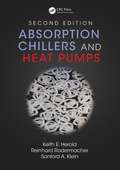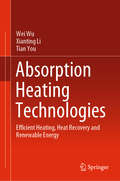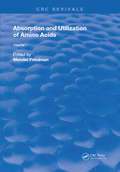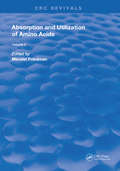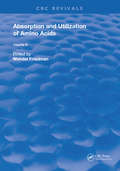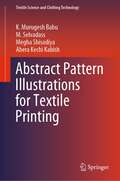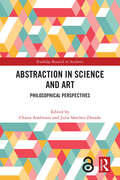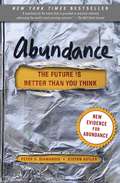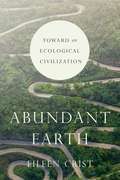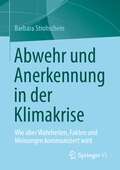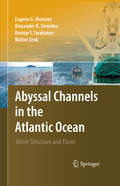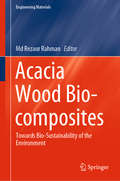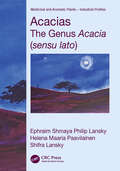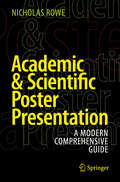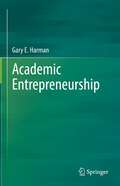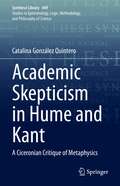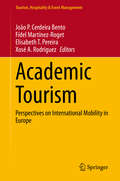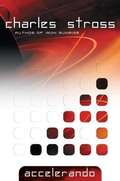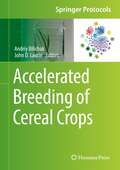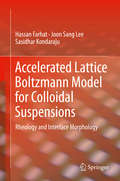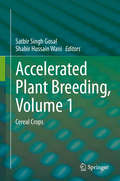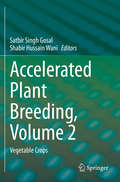- Table View
- List View
Absorption Chillers and Heat Pumps
by Keith E. Herold Reinhard Radermacher Sanford A. KleinSignificantly revised and updated since its first publication in 1996, Absorption Chillers and Heat Pumps, Second Edition discusses the fundamental physics and major applications of absorption chillers. While the popularity of absorption chillers began to dwindle in the United States in the late 1990's, a shift towards sustainability, green buildin
Absorption Heating Technologies: Efficient Heating, Heat Recovery and Renewable Energy
by Wei Wu Xianting Li Tian YouThis book offers a comprehensive introduction to novel absorption heating technologies for improving the energy efficiency of heating systems. The proposed low-temperature heating systems, based on an air source absorption heat pump (ASAHP), significantly increase heating efficiency and reduce pollution emissions. As the performance of ASAHPs deteriorates at lower ambient/driving temperatures, a series of advanced cycles is used to extend their applicability, with the compression-assisted ASAHP being the most outstanding example. The book discusses the generator-absorber-heat-exchange ASAHP as a promising solution to make the best of high driving temperatures, an aspect that can be improved further via compression. Further, it addresses the ground source absorption heat pump (GSAHP), which eliminates the soil thermal imbalance of the conventional ground source electrical heat pump (GSEHP), and also reduces the number of boreholes . Various hybrid GSAHP systems are proposed to further enhance applicability, efficiency, and economy: these include a combined GSAHP and GSEHP system, as well as ASAHP and GSAHP systems that incorporate design optimizations. In closing, the book explores the merits of novel working fluids and highlights recent advances concerning waste heat and renewable energy utilization.
Absorption and Utilization of Amino Acids: Volume I
by Mendel FriedmanContaining 45 papers written by outstanding international authors from 14 countries, this three-volume compendium brings together the elements needed to understand the factors which influence the utilization of amino acids. The wide-ranging topics include descriptions of metabolic pathways and mechanisms of the biological utilization of amino acids, as well as factors that influence amino acid bioavailability in enteral and parenteral nutrition. The use of amino acids to improve the quality and safety of the diet is presented. Also discussed are amino acid precursors of biogenic amines and the role of amino acids in atherosclerosis, cancer, and immunity. Scientists from many disciplines will benefit from this broad overview.
Absorption and Utilization of Amino Acids: Volume II
by Mendel FriedmanContaining 45 papers written by outstanding international authors from 14 countries, this three-volume compendium brings together the elements needed to understand the factors which influence the utilization of amino acids. The wide-ranging topics include descriptions of metabolic pathways and mechanisms of the biological utilization of amino acids, as well as factors that influence amino acid bioavailability in enteral and parenteral nutrition. The use of amino acids to improve the quality and safety of the diet is presented. Also discussed are amino acid precursors of biogenic amines and the role of amino acids in atherosclerosis, cancer, and immunity. Scientists from many disciplines will benefit from this broad overview.
Absorption and Utilization of Amino Acids: Volume III
by Mendel FriedmanContaining 45 papers written by outstanding international authors from 14 countries, this three-volume compendium brings together the elements needed to understand the factors which influence the utilization of amino acids. The wide-ranging topics include descriptions of metabolic pathways and mechanisms of the biological utilization of amino acids, as well as factors that influence amino acid bioavailability in enteral and parenteral nutrition. The use of amino acids to improve the quality and safety of the diet is presented. Also discussed are amino acid precursors of biogenic amines and the role of amino acids in atherosclerosis, cancer, and immunity. Scientists from many disciplines will benefit from this broad overview.
Abstract Pattern Illustrations for Textile Printing (Textile Science and Clothing Technology)
by K. Murugesh Babu M. Selvadass Megha Shisodiya Abera Kechi KabishThis book is intended for textile designers, fashion designers, and for those interested in the integration of graphic design with textile surface printing. The book discusses how abstract graphic designs with intense color palette range work on different types of fabrics, will be beneficial for designers. The book provides beautiful illustrations of abstract designs that can be used directly for textile printing and also acts as inspiration (or motivation) for development of new designs. Abstract designs represent an accurate depiction of a visual reality and uses shapes, colors and forms to achieve its effect. This book provides illustrations that show the importance of color and color combinations with bright, warm and dull colors. The book presents flawless illustrations with great harmony between the diverse shapes and overall color combinations. All the illustrations in this book are explained briefly. The illustrations can also be used in other areas like wall paper design, packaging design, ceramic design and many more.
Abstraction in Science and Art: Philosophical Perspectives (Routledge Research in Aesthetics)
by Chiara Ambrosio Julia Sánchez-DoradoThis volume explores the roles and uses of abstraction in scientific and artistic practice. Conceived as an interdisciplinary dialogue between experts across histories and philosophies of art and science, this collection of essays draws on the shared premise that abstraction is a rich and generative process, not reducible to the mere omission of details in a representation.When scientists attempt to make sense of complex natural phenomena, they often produce highly abstract models of them. In the history and philosophy of art, there is a long tradition of debate on the function of abstraction, and – more recently – its relation with theories of depiction. Adopting a process-oriented perspective, the chapters in this volume explore the epistemic potential of a diversity of practices of abstracting. The systematic analysis of a wide range of historical cases, from early twentieth-century abstractionist painting to contemporary abstract photography, and from nineteenth-century physics to recent research in biology and neurosciences, invites the reader to reflect on the material lives of abstraction through concrete artefacts, experimental practices, and theoretical and aesthetic achievements.Abstraction in Science and Art: Philosophical Perspectives will be of interest to scholars and advanced students working in aesthetics, philosophy of science, and epistemology, as well as to historians of science and art, and to practicing artists and scientists interested in exploring foundational questions at the heart of the creative practice of abstracting.The Open Access version of this book, available at www.taylorfrancis.com, has been made available under a Creative Commons Attribution-Non Commercial-No Derivatives (CC-BY-NC-ND) 4.0 license.Open access for this book was funded by University College London.
Abundance: The Future Is Better Than You Think (Exponential Technology Series)
by Steven Kotler Peter H. DiamandisThe New York Times bestselling &“manifesto for the future that is grounded in practical solutions addressing the world&’s most pressing concerns: overpopulation, food, water, energy, education, health care and freedom&” (The Wall Street Journal).Since the dawn of humanity, a privileged few have lived in stark contrast to the hardscrabble majority. Conventional wisdom says this gap cannot be closed. But it is closing—and fast. In Abundance, space entrepreneur turned innovation pioneer Peter H. Diamandis and award-winning science writer Steven Kotler document how progress in artificial intelligence, robotics, digital manufacturing synthetic biology, and other exponentially growing technologies will enable us to make greater gains in the next two decades than we have in the previous 200 years. We will soon have the ability to meet and exceed the basic needs of every person on the planet. Abundance for all is within our grasp. Breaking down human needs by category—water, food, energy, healthcare, education, freedom—Diamandis and Kotler introduce us to innovators and industry captains making tremendous strides in each area. &“Not only is Abundance a riveting page-turner…but it&’s a book that gives us a future worth fighting for&” (The Christian Science Monitor).
Abundant Earth: Toward an Ecological Civilization
by Eileen CristIn Abundant Earth, Eileen Crist not only documents the rising tide of biodiversity loss, but also lays out the drivers of this wholesale destruction and how we can push past them. Looking beyond the familiar litany of causes—a large and growing human population, rising livestock numbers, expanding economies and international trade, and spreading infrastructures and incursions upon wildlands—she asks the key question: if we know human expansionism is to blame for this ecological crisis, why are we not taking the needed steps to halt our expansionism? Crist argues that to do so would require a two-pronged approach. Scaling down calls upon us to lower the global human population while working within a human-rights framework, to deindustrialize food production, and to localize economies and contract global trade. Pulling back calls upon us to free, restore, reconnect, and rewild vast terrestrial and marine ecosystems. However, the pervasive worldview of human supremacy—the conviction that humans are superior to all other life-forms and entitled to use these life-forms and their habitats—normalizes and promotes humanity’s ongoing expansion, undermining our ability to enact these linked strategies and preempt the mounting suffering and dislocation of both humans and nonhumans.Abundant Earth urges us to confront the reality that humanity will not advance by entrenching its domination over the biosphere. On the contrary, we will stagnate in the identity of nature-colonizer and decline into conflict as we vie for natural resources. Instead, we must chart another course, choosing to live in fellowship within the vibrant ecologies of our wild and domestic cohorts, and enfolding human inhabitation within the rich expanse of a biodiverse, living planet.
Abwehr und Anerkennung in der Klimakrise: Wie über Wahrheiten, Fakten und Meinungen kommuniziert wird
by Barbara StrohscheinAuf Wahrheiten, Fakten und Meinungen zur Klimafrage wird häufig öffentlich wie privat mit psychischer oder sozialer Abwehr reagiert. Gestützt auf ausgewählte psychologische und philosophische Theorien sowie Datenmaterial wird in diesem Buch gezeigt, wie Abwehr zustande kommt, wie sie wirkt und wie andererseits die notwendige Anerkennung auf verschiedenen Ebenen gelingen kann. Erst durch Anerkennung werden konstruktive Diskurse möglich. Dieses Buch bietet alle Grundlagen, um Kommunikationskonflikte zwischen Abwehr und Anerkennung in der Klimakrise theoretisch und praktisch lösen zu können.
Abyssal Channels in the Atlantic Ocean: Water Structure and Flows
by Alexander N. Demidov Eugene G. Morozov Roman Y. Tarakanov Walter ZenkThis book is dedicated to the study of structure and transport of deep and bottom waters through underwater channels of the Atlantic Ocean. The study is based on recent observations, analysis of historical data, and literature review. A strong flow of Antarctic Bottom Water from the Argentine Basin to the Brazil Basin through the Vema Channel (32 -27 S) is studied on the basis of CTD sections combined with LADCP profiling carried out annually and long-term moored measurements. The flow in the Vema Channel is mixed in the vertical direction but horizontally stratified. The mean speed of the flow is 30 cm/s and water transport is approximately 3.5 Sv. Owing to the bottom Ekman friction the dense core of the flow is usually displaced to the eastern wall of the channel. A temperature increase was found in the deep Vema Channel, which has been observed for 30 years already. The further flow of bottom water in the Brazil Basin splits in the northern part of the basin. Part of water flows to the East Atlantic basins through the Romanche and Chain fracture zones. The other part is a northwestern flow to the North American Basin. Part of the northwesterly flow propagates through the Vema Fracture Zone (11 N) into the Northeastern Atlantic basins. Flows in the Romanche, Chain, and Vema fracture zones were studied recently by CTD and LADCP profiling. An underwater cataract was found in the Chain Fracture Zone. Recent measurements in the Kane Gap show that the flow of bottom water there is characterized by alternative transport in time. The Northeastern Atlantic basins are filled with the bottom water flowing through the Vema Fracture Zone. The flows of bottom waters through the Romanche and Chain fracture zones do not spread to the Northeast Atlantic due to strong mixing in the equatorial zone and enhanced transformation of bottom water properties. Extra material: The CTD data sets collected in abyssal channels of the Atlantic Ocean can be downloaded from http://extras.springer.com. The access to the data is organized either by means of a clickable map or tables. Investigators can download individual casts organized by the year of the experiment or its location. The CTD data are organized in the form of a heading and three columns (pressure, temperature, salinity). The style is similar to the WOCE format. A line with coordinates is added to the heading.
Acacia Wood Bio-composites: Towards Bio-Sustainability of the Environment (Engineering Materials)
by Md Rezaur RahmanThis book investigates the enhancement of properties of acacia wood and its surface treatment for high strength bio-composites. It describes the tensile, flexural and impact strength, surface behaviour, morphological analysis, infrared spectral functional analysis, thermal properties analysis and dielectrical properties of acacia wood bio-composites. It reports efforts on the optimization of fabrication techniques to prepare acacia wood reinforced bio-composites based on PLA, PHA, Etc. The book also reports on environmental impact analysis of acacia wood bio-composites. A special chapter is dedicated to the nano-enhancement of acacia wood bio-composites and their possible use in applications in terms of sustainability and economics.
Acacias: The Genus Acacia (sensu lato) (Medicinal and Aromatic Plants - Industrial Profiles #1)
by Shifra Lansky Helena Maaria Paavilainen Ephraim Philip LanskyAcacias: The Genus Acacia (sensu lato) is an evidence-based treatment of this supergenus, through the eyes of a clinical pharmacognosist and integrative medicine specialist. The book begins with antiviral activity, revealing within the five genera of Acacia s.l., pharmacological properties and pharmacologically active compounds. Profiles of prominent species within these genera, including photographs, accompany the narrative of current research and traditional usage into antibacterial, antifungal, anticancer, antidiabetic, metabolic syndrome ameliorative, and psychotherapeutic potential. Features Comprehensive treatment of the entire Acacia sensu lato genus Aids ethnopharmacological prospectors of new sources of novel botanically based medicines for modern metabolic and psychiatric diseases Illuminates the presence of psychedelic simple substituted tryptamines in trees and their medical and psychotherapeutic potential Continuing in the tradition of the previous volumes of the esteemed Medicinal and Aromatic Plants: Industrial Profiles series, Acacias: The Genus Acacia (sensu lato) provides a unique and comprehensive coverage of one of the most interesting and diverse genera of trees, firmly entrenched in the Levant, Africa, Australia, the Far East, and the New World. The influence of these genera on pharmacy and industry (especially through gum arabic, wildcrafted in Africa from Senegalia senegal), human consciousness, the advent and development of religions, planetary ecology, botanical therapeutics, and the emergence of psychedelic medicine reflect both the history of our species and the transformative promise of tomorrow.
Academic & Scientific Poster Presentation: A Modern Comprehensive Guide
by Nicholas RoweThis book offers the first comprehensive guide to poster presentation at academic, scientific and professional conferences. Each chapter explores different factors that impact upon how posters function, and how they fit within today's conference practices, as well as provides guidance on how to address compilation and presentation issues with the poster medium. Drawing from fields of education, psychology, advertising and other areas, the book offers examples of how theories may be applied to practice in terms of both traditional paper and electronic poster formats. Importantly, the book offers a critical examination of how academic and scientific posters are able to achieve their potential for knowledge dissemination, networking and knowledge transfer. The many new and challenging findings provide an evidence-based approach to help both novice and experienced presenters compile effective poster presentations, and to see how poster presentations can best be used to share knowledge, facilitate networking, and promote dialogue. Additionally, educators, employers, and conference organizers may use this book to re-evaluate how conferences meet the needs of today's globally connected peer groups, and the benefit they provide at individual and group levels.
Academic Entrepreneurship
by Gary E. HarmanThis book explores different aspects of entrepreneurship from both an academic and a commercial point of view. The first chapter the university culture is considered. The nature of the technology or service is important. Some technologies are adaptive, in that they are developing products that are already in the marketplace, and these fit easily in academic institutions. Other technologies are disruptive and new products must be developed. These fit less easily into university structures since a commercial entity is required. Chapter 4 considers the important requirements of conflict of interest (COI). Either the university culture or COI can hinder or aid entrepreneurial faculty. The second chapter deals with the reasons why an individual faculty might wish to become entrepreneurial. In many cases, a faculty member wants to see their technology in practice and not just a publication in a scientific journal. If a technology is disruptive, then a commercial entity is probably essential. If so, then funding must be obtained. There are “valleys of death” (1) where scientific discoveries to useful products and (2) the development, production and marketing of a commercially viable product. Chapter 6 deals specifically with methods of funding start-up companies. Chapter 3 describes several innovative programs in biology. These include genetic approaches, plant management systems and the author’s own program that deals with microbial approaches to sustainable agriculture. Chapter 5 describes the crucial areas of agreements, contracts, regulatory affairs and patents. These legal documents are critical components of entrepreneurial efforts and must be understood and pursued correctly. Finally, this book could have been entitled “things I wish I had known when I first started commercial activities.” It is my hope that it can make the path of fledgling entrepreneurial smoother and more successful.
Academic Entrepreneurship: How to Bring Your Scientific Discovery to a Successful Commercial Product
by Michele MarcolongoThe pathway to bringing laboratory discoveries to market is poorly understood and generally new to many academics. This book serves as an easy-to-read roadmap for translating technology to a product launch – guiding university faculty and graduate students on launching a start-up company.• Addresses a growing trend of academic faculty commercializing their discoveries, especially those supported by the National Science Foundation and National Institutes of Health• Offers faculty a pathway and easy-to-follow steps towards determining whether their discovery / idea / technology is viable from a business perspective, as well as how to execute the necessary steps to create and launch a start-up company• Has a light-hearted and accessible style of a step-by-step guide to help graduate students, post-docs, and faculty learn how to go about spinning out their research from the lab• Includes interviews by faculty in the disciplines of materials science, pharmaceuticals, medical devices, information technology, energy, and mechanical devices – offering tips and discussing potential pitfalls to be avoided
Academic Skepticism in Hume and Kant: A Ciceronian Critique of Metaphysics (Synthese Library #449)
by Catalina González QuinteroThis book offers an unprecedented study of the influence of the skepticism of the New Platonic Academy on David Hume’s and Immanuel Kant’s critiques of metaphysics. By demonstrating how the skeptical teachings of the Academy affected these authors’ Enlightened attacks on traditional metaphysics, this book deepens and broadens the burgeoning scholarship on the role that the Ancients schools of skepticism played in the configuration of Modern skeptical outlooks. It bolsters the newfound recognition that we must reconsider the conventional view that the revival of Pyrrhonism in the sixteenth and seventeenth centuries gave birth to Modern skepticism by incorporating the influence of Academic skepticism in the analysis.Giving a new impetus to this line of research, the author argues that Academic ideas and methods informed Hume’s and Kant’s critique of metaphysics in substantial and thus far unacknowledged ways. Specifically, she demonstrates the centrality of Academic skepticism to Hume’s epistemology and critique of religion through a detailed analysis of his theory of belief in the Treatise and the first Enquiry as well as of its application in the Dialogues concerning Natural Religion. Likewise, her analysis reveals how Kant’s anti-metaphysical stance, developed in the Transcendental Dialectic of the Critique of Pure Reason, contains many skeptical insights of Academic inspiration, bequeathed to him by Hume.
Academic Tourism: Perspectives on International Mobility in Europe (Tourism, Hospitality & Event Management)
by João P. Cerdeira Bento Fídel Martínez-Roget Elisabeth T. Pereira Xosé A. RodríguezThis book presents the latest knowledge on the still under-researched field of academic tourism, which over the past decade has gained in importance at local and national economic levels as a result of increasing international mobility of students and academic staff in higher education. A wide range of themes are explored from various perspectives, with the focus on Europe. Particular attention is paid to academic tourism demand, expenditure, and economic impact; the relationships between academic tourism and local and regional development, sustainable development, and environmental sustainability; and the importance of academic tourism for the internationalization of higher education and international cooperation and development. Further topics to be considered include the significance of academic tourism for the dynamics of tourism destinations and insights from experimental tourism research. In addition to theoretical chapters and state of the art reviews, readers will find insightful empirical and case studies. The book will be of interest to academics, researchers, students, and practitioners, including policy makers.
Accelerando (Singularity #3)
by Charles StrossThe Singularity. It is the era of the posthuman. Artificial intelligences have surpassed the limits of human intellect. Biotechnological beings have rendered people all but extinct. Molecular nanotechnology runs rampant, replicating and reprogramming at will. Contact with extraterrestrial life grows more imminent with each new day. Struggling to survive and thrive in this accelerated world are three generations of the Macx clan: Manfred, an entrepreneur dealing in intelligence amplification technology whose mind is divided between his physical environment and the Internet; his daughter, Amber, on the run from her domineering mother, seeking her fortune in the outer system as an indentured astronaut; and Sirhan, Amber's son, who finds his destiny linked to the fate of all of humanity. For something is systematically dismantling the nine planets of the solar system. Something beyond human comprehension. Something that has no use for biological life in any form...
Accelerated Breeding of Cereal Crops (Springer Protocols Handbooks)
by Andriy Bilichak John D. LaurieThis volume provides a comprehensive collection of methods for plant breeders and researchers working in functional genomics of cereal crops. Chapters detail advances in sequencing of cereal genomes, methods of traditional plant breeding, use of machine learning for genomic selection, random and targeted mutagenesis with CRISPR/Cas9, quantitative proteomics and phenotyping in cereals. Authoritative and cutting-edge, Accelerated Breeding of Cereal Crops aims to be of interest to plant breeders, researchers, postdoctoral fellows, and students working in functional genomics for the development of the next generation of crop plants.
Accelerated Cosmic Expansion: Proceedings of the Fourth International Meeting on Gravitation and Cosmology (Astrophysics and Space Science Proceedings #38)
by Claudia Moreno González José Edgar Madriz Aguilar Luz Marina Reyes BarreraProceedings from the 2012 Fourth International Meeting on Gravitation and Cosmology, focusing on accelerated cosmic expansion This volume provides both an update and a review of the state of alternative theories of gravity in connection with the accelerated expansion of the universe issue. Different theoretical proposals exist to explain the acceleration in the cosmic expansion, generating the dark energy issue and opening the possibility to theories of gravity alternative to general relativity. Related issues such as the dark matter problem are also surveyed in order to give the readers profound insight on the subject from different points of view. Comprised of short talks and plenary lectures given by leading experts in the field, some of them with brilliant and historic contributions, the book allows the reader to find readable and referenced surveys in topics like f(R) theories, the dark matter and dark energy issues, Modified Newtonian Dynamics (MOND) scenarios, f(T) theories, scalar-tensor theories derived from non-Riemannian geometries, emergent universes, the cosmological constant and other topics of current interest for younger and senior physicists and graduate students. These proceedings are from the Fourth International Meeting on Gravitation and Cosmology, held in Guadalajara, Jalisco, México, from 20 - 25 May, 2012, was sponsored by ICTP- Trieste, Italy and COECyTJAL-Universidad de Guadalajara, México. This event is a series of scientific meetings started in 2004 in Cuba, focusing on current and selected topics in the fields of gravitation and cosmology.
Accelerated Lattice Boltzmann Model for Colloidal Suspensions: Rheology and Interface Morphology
by Hassan Farhat Joon Sang Lee Sasidhar KondarajuColloids are ubiquitous in the food, medical, cosmetics, polymers, water purification, and pharmaceutical industries. The thermal, mechanical, and storage properties of colloids are highly dependent on their interface morphology and their rheological behavior. Numerical methods provide a convenient and reliable tool for the study of colloids. Accelerated Lattice Boltzmann Model for Colloidal Suspensions introduce the main building-blocks for an improved lattice Boltzmann-based numerical tool designed for the study of colloidal rheology and interface morphology. This book also covers the migrating multi-block used to simulate single component, multi-component, multiphase, and single component multiphase flows and their validation by experimental, numerical, and analytical solutions. Among other topics discussed are the hybrid lattice Boltzmann method (LBM) for surfactant-covered droplets; biological suspensions such as blood; used in conjunction with the suppression of coalescence for investigating the rheology of colloids and microvasculature blood flow. The presented LBM model provides a flexible numerical platform consisting of various modules that could be used separately or in combination for the study of a variety of colloids and biological flow deformation problems.
Accelerated Plant Breeding, Volume 1: Cereal Crops
by Shabir Hussain Wani Satbir Singh GosalPlant improvement has shifted its focus from yield, quality and disease resistance to factors that will enhance commerical export, such as early maturity, shelf life and better processing quality. Conventional plant breeding methods aiming at the improvement of a self-pollinating crop, such as wheat, usually take 10-12 years to develop and release of the new variety. During the past 10 years, significant advances have been made and accelerated methods have been developed for precision breeding and early release of crop varieties. This work summarizes concepts dealing with germplasm enhancement and development of improved varieties based on innovative methodologies that include doubled haploidy, marker assisted selection, marker assisted background selection, genetic mapping, genomic selection, high-throughput genotyping, high-throughput phenotyping, mutation breeding, reverse breeding, transgenic breeding, shuttle breeding, speed breeding, low cost high-throughput field phenotyping, etc. It is an important reference with special focus on accelerated development of improved crop varieties.
Accelerated Plant Breeding, Volume 2: Vegetable Crops
by Shabir Hussain Wani Satbir Singh GosalPlant improvement has shifted its focus from yield, quality and disease resistance to factors that will enhance commercial export, such as early maturity, shelf life and better processing quality. Conventional plant breeding methods aiming at the improvement of a self-pollinating crop, such as wheat, usually take 10-12 years to develop and release of the new variety. During the past 10 years, significant advances have been made and accelerated methods have been developed for precision breeding and early release of crop varieties. This edited volume summarizes concepts dealing with germplasm enhancement and development of improved varieties based on innovative methodologies that include doubled haploidy, marker assisted selection, marker assisted background selection, genetic mapping, genomic selection, high-throughput genotyping, high-throughput phenotyping, mutation breeding, reverse breeding, transgenic breeding, shuttle breeding, speed breeding, low cost high-throughput field phenotyping, etc. It is an important reference with special focus on accelerated development of improved crop varieties.
Accelerated Plant Breeding, Volume 3: Food Legumes
by Shabir Hussain Wani Satbir Singh GosalPlant improvement has shifted its focus from yield, quality and disease resistance to factors that will enhance commercial export, such as early maturity, shelf life and better processing quality. Conventional plant breeding methods aiming at the improvement of a self-pollinating crop, such as wheat, usually take 10-12 years to develop and release of the new variety. During the past 10 years, significant advances have been made and accelerated methods have been developed for precision breeding and early release of crop varieties. This work summarizes concepts dealing with germplasm enhancement and development of improved varieties based on innovative methodologies that include doubled haploidy, marker assisted selection, marker assisted background selection, genetic mapping, genomic selection, high-throughput genotyping, high-throughput phenotyping, mutation breeding, reverse breeding, transgenic breeding, shuttle breeding, speed breeding, low cost high-throughput field phenotyping, etc. It is an important reference with special focus on accelerated development of improved crop varieties.
